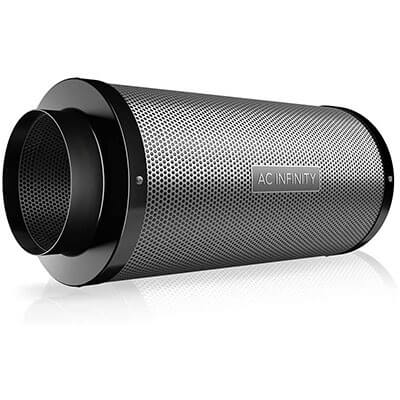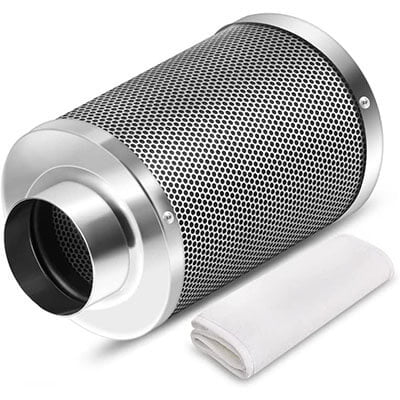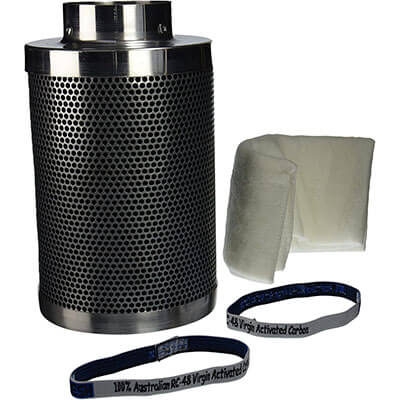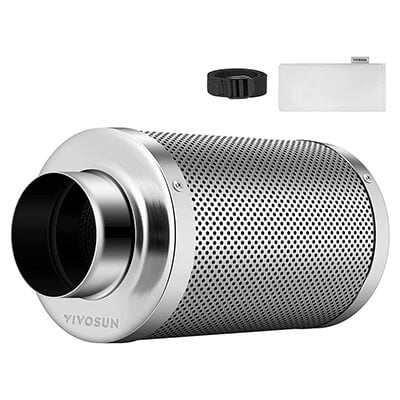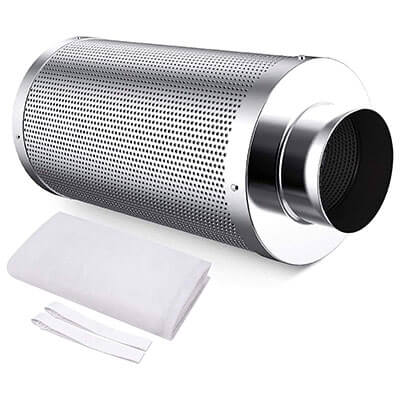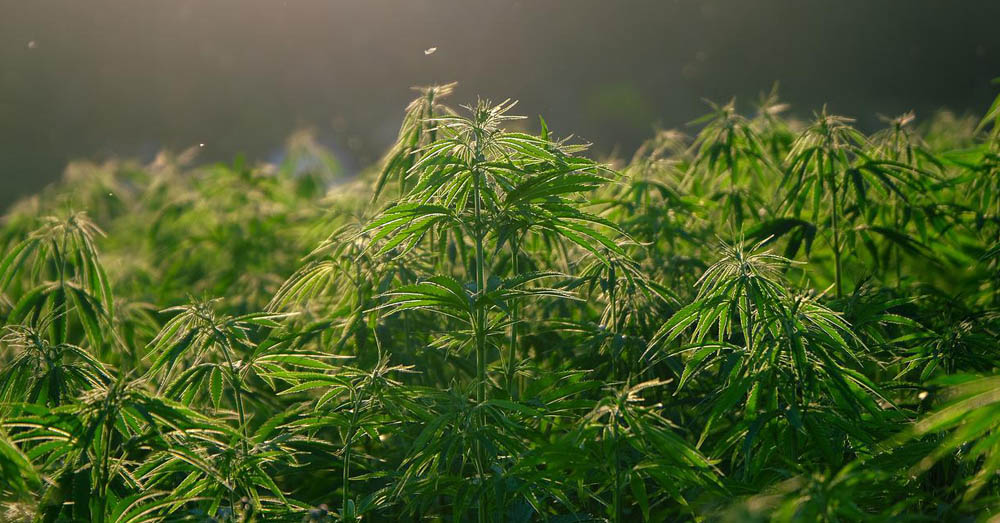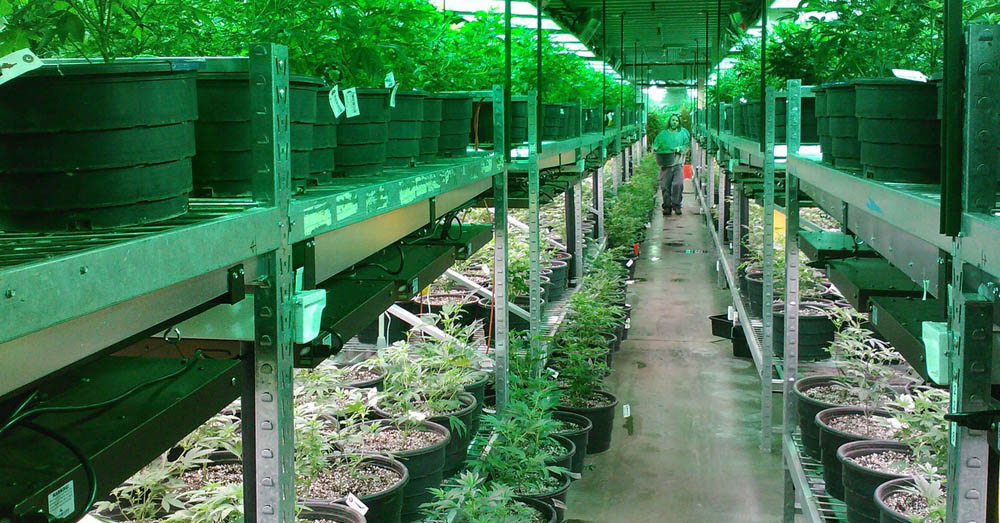Indoor plants NATURALLY create odors that even the best grow tents for cannabis can’t contain by themselves.
But I have some good news for you! You can get rid of the most undesirable odors with the help of a carbon filter for grow room.
In this article, I’ll talk about the best carbon filters you can get. I’ve even included a quick guide to choosing the right one for your needs.
6 Best Carbon Filters for Grow Rooms
Here are my top carbon filters for effective odor control in your grow room:
1) AC Infinity Air Carbon Filter – Best Overall
My top pick is AC Infinity’s POWERFUL carbon filter with a rating of 1200+ IAV. It also has a solid airflow rating of 410 CFM.
I think the best part about this is that its charcoal bed is 60 mm thick for better odor control.
Alongside that is a 55% open mesh area that doesn’t restrict the airflow while the activated carbon inside absorbs the odor.
Combined, the thick bed and open mesh let this best carbon filter last up to 33% longer.
AC Infinity offers a 12-inch, 10-inch, 8-inch, 6-inch, and 4-inch air carbon filter — so it’s perfect for any grow room size.
However, I won’t say this is the best carbon filter for a lightweight grow tent.

PROS
- Quiet
- High absorption rate
- Comes in five sizes

CONS
- Can be heavy for lightweight tents
- Straps or installation belts aren’t included
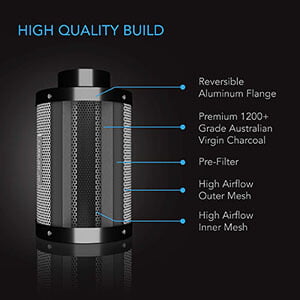
Rating: 4.8/5
2) TerraBloom Carbon Filter – Best Value
The TerraBloom Premium Carbon Filter offers great features for its price.
For one, it has a carbon bed that’s 46 mm thick — which lets you absorb 15% more carbon than most filters.
It comes with two machine-washable pre-filters and has a great 90-day warranty from the manufacturer. If you take good care of this filter, it can last up to two years.
Like other carbon filters, you can use this model as an intake filter or exhaust filter. It’s rated up to 200 CFM, but depending on the size of your model, it can go somewhat HIGHER.
However, I noticed that it doesn’t operate quietly. But it’s easy to fix by using a clamp.
Nevertheless, this is the best carbon filter if you want to get a bang for your buck.
TerraBloom also offers a 4-inch, 6-inch, and 8-inch carbon filter.

PROS
- Good warranty
- Can last up to two years

CONS
- Not quiet
- Too heavy for small tents
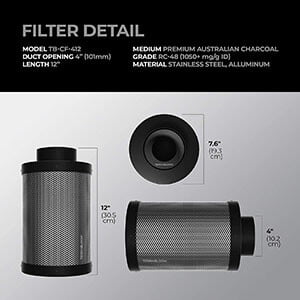
Rating: 4.7/5
3) iPower Air Carbon Filter – Best Budget
iPower’s product is the best carbon filter to get if you don’t want to break the bank.
Though it’s my budget pick, I’m surprised to find that it offers great filtering performance.
In fact, it has a 50 mm charcoal bed, which makes for really effective odor control. It also has an inner and outer mesh with a 53% open area to help increase the airflow.
This also means you can use it as an intake filter or exhaust filter.
You can flip the filter body upside down to make it last longer.
It can help control the odor in an inline fan with the help of Australian Virgin Charcoal.
The carbon filter is also made of ALUMINUM, making it lighter than other filters.
Its built-in flange can typically fit a laminar airflow or inline fan — however, since it’s not made to specifically fit anything, it can sometimes be tricky to actually fit it.
iPower offers 4-inch, 6-inch, and 12-inch carbon filters.

PROS
- Lightweight
- Affordable
- Great filtering performance

CONS
- Can be tricky to fit
- Doesn’t last as long as other filters
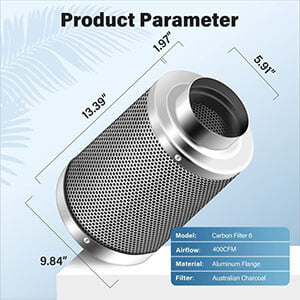
Rating: 4.6/5
4) Phresh Carbon Filter – Best Premium Filter
If you have enough money to spare, I recommend Phresh’s product as the best carbon filter to try.
It has a washable polyester screen for a pre-filter wrapped around the product.
As for the filter itself, Phresh uses Nano carbon technology for the best absorption possible. This is integrated into the 1.8-inch carbon layer.
The steel mesh has a 51% opening for the best airflow, but the flanges are lighter since they’re made of aluminum.
It’s an especially great product if you use it with a 4-inch inline fan.
This carbon filter can last longer than two years if you have a less humid grow room.
However, the Phresh carbon filter doesn’t ALWAYS withstand heavy usage, so be careful.
Phresh also has a 4-inch, 6-inch, and 8-inch carbon filter.

PROS
- Lasts long
- Uses Nano carbon technology

CONS
- Expensive
- Doesn’t always withstand heavy usage
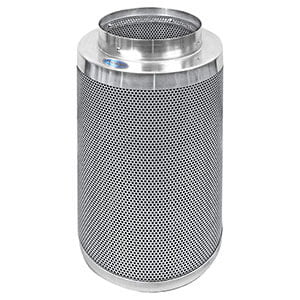
Rating: 4.5/5
5) Vivosun Air Carbon Filter – Best Airflow Rating
In my opinion, Vivosun’s model would be the best carbon filter for beginners.
That’s because it’s really easy to set up!
After all, it comes with instructions on how you can install it in different ways. But if you want to keep things simple, you can just suspend the filter over the plants.
What impressed me the most about Vivosun’s filter is that it has a CFM of up to 500. You also get a double layer of mesh that gives you a 53% increase in ventilation.
This means it can also be used both as an intake filter and an exhaust filter.
However, this ventilation system isn’t the best for very heavy odors. You should also be careful since this particular air filter can raise the temperature inside the tent.

PROS
- Can handle up to 500 CFM
- Easy to set up
- Includes a carbon filter belt

CONS
- Not the best for very heavy odors
- Filter can increase the temperature in grow tent
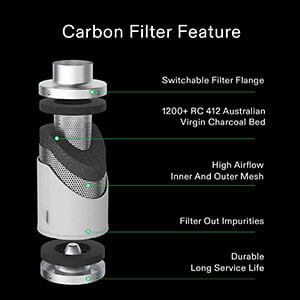
Rating: 4.4/5
6) Amagabeli Carbon Filter – Most Versatile
I’ve named Amagabeli’s carbon filter as the most versatile since it has reversible filtration. This allows it to work for both intake filtration AND exhaust filtration
It has an inner and outer mesh made of galvanized steel with a 55% open area, greatly reducing air volume loss.
The machine-packed carbon and 1050+ IAV charcoal also result in a 99.8% filtered airflow.
Aside from that, this 4-inch air carbon filter for grow room can also be used for other equipment, such as:
- 4-inch inline fans
- Duct fans
- Can fans
- Exhaust fans
- Intake fans
- Ventilation ducts
- Air exchange fans
- Air ducts
- Vent duct hoses
- Paint fumes hose
- Fan speed controllers
It comes with a washable pre-filter that you can EASILY mount with elastic bands.However, I wouldn’t say this is the best option for a lightweight grow tent. Some reviews also complain that it doesn’t always fit as expected.

PROS
- Heavy-duty
- Reversible filtration
- Can work well with other parts of the ventilation system

CONS
- Might not be good for lightweight tents
- Doesn’t always fit as expected
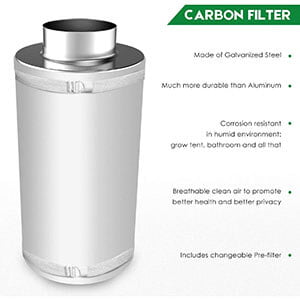
Rating: 4.3/5
Benefits of Carbon Filters
Whether you’re a newbie or an old-timer in managing indoor plants in grow rooms, let me list down the multiple benefits having the right carbon filter can give you:
Removes Air Pollutants
The air can contain chemical irritants, compounds, and other impurities that can hinder your indoor plants from growing properly — or even kill them outright.
Removing air pollutants is even more important since grow rooms have their own contained environment. As such, improving the air quality gives your plants a chance to grow well.
Manages Odors
Some people like the smell of indoor plants and gardens. But if unmanaged, this odor can be too strong and foul.
Not to mention, it might be a sign that air pollutants have spread around your grow tent.
After all, you also likely use fertilizers, pesticides, and other products to support the growth of your indoor plants.
Having the right carbon filter for grow room traps those volatile organic compounds, helping get rid of the foul smell.
Ventilate Grow Rooms
Carbon filters used with an inline fan ensure that your plants always have cool fresh air.
Maximum airflow also helps regulate temperature and improve air quality.
Absorbs Ozone
Ozone buildup happens FASTER when it concerns indoor plants.
Ozone is a big contributor to the smog that you see in cities — and too much of that is dangerous for your plants.
Fortunately, carbon air filters are very useful in managing ozone within your grow tent.
How Do Carbon Filters Work?
A carbon filter works thanks to the activated charcoal it contains. This absorbent carbon removes air pollutants (such as allergens and pathogens) in the grow room.
That’s because charcoal has PORES, which can trap air molecules.
Air passes through the charcoal canister, and the carbon it contains takes that air out of circulation.
The carbon reacts to any impurity in that air and traps them within the screen. This leaves the air clean and free of bad smells.
Of course, a carbon filter CANNOT work alone. After all, the air won’t just float into it.
As such, you’ll need an exhaust fan to force the air into the filter to stick to the activated carbon.
Factors to Consider When Choosing the Best Carbon Filter for Your Grow Room
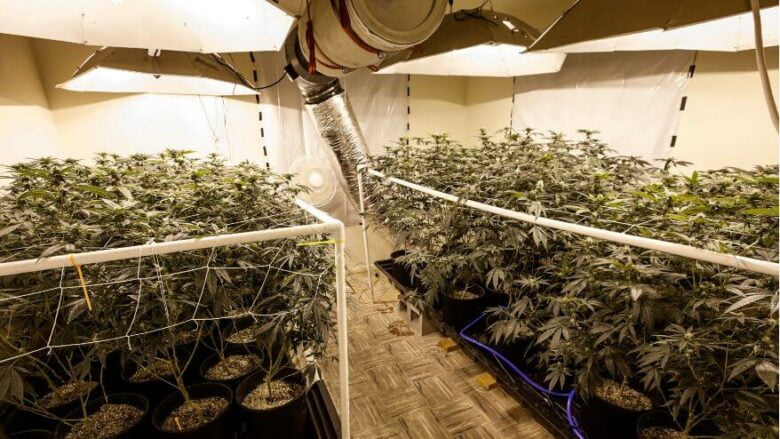
The market offers many carbon filters. To help you find the best carbon filter for your grow room, I’ve listed some factors to keep in mind below:
1) Grow Tent Size
Carbon filters come in different sizes.
The smallest one — the 4-inch air carbon filter — is enough for small grow tents for plants. Here’s a quick rule of thumb for other tent sizes and which carbon filter size would be good:
- 3×3 grow tent – 4-inch air carbon filter
- 4×4 grow tent – 4-inch air carbon filter
- 5×5 grow tent – 6-inch air carbon filter
- 4×8 grow tent – 8-inch air carbon filter
- 10×10 grow tent – 8-inch air carbon filter
- 12×12 grow tent – 12-inch air carbon filter
Remember that your grow tent should be able to contain the carbon filter and other equipment you’ll need — such as lights or a fan for grow tent.
2) Material
Carbon filters are made from aluminum, steel, or both.
Steel is heavy-duty. However, it also makes the carbon filter HEAVIER. Meanwhile, aluminum is much lighter.
A good compromise is using steel for the body and having an aluminum mesh and/or flanges.
This ensures that you get a durable frame while making the carbon filter as light as possible.
3) Durability
Having sturdy carbon filters depends on various things — from the environment inside your grow room to your filter’s construction.
I’ve broken down these additional factors below:
Pre-filter
As the name suggests, a pre-filter is what the air passes through before it reaches the actual carbon bed. This stops dust particles from entering the carbon filter.
Aside from saving your carbon filter, it also extends the life of other equipment used with the filter — such as the inline fan, which acts as an exhaust fan in the grow room.
Pre-filters are also removable and washable. A good rule of thumb here is to change or wash the pre-filter every six months.
They’re found outside the carbon filter, and some come with a velcro pre-filter belt to keep them in place.
Quality of Carbon Factor
Carbon filters are rated by how much activated carbon they contain. This greatly affects how long your charcoal air filter will live.
Thicker carbon filters work longer than others since they’re more effective in absorbing odor and transporting them to the carbon granules.
That’s because they don’t have air pockets, which still allows chemical irritants to still pass through.
As such, compact carbon filters will also work with less noise and vibration.
Size of Filter and Room
The size of your carbon filter should be just right for your grow room.
After all, a small filter will get dirtier FASTER in a larger grow tent. They won’t be able to handle the volume of air passing through them, so they won’t last as long as they should.
Pollution
Simply put, the dustier of a grow room you put the carbon filter in, the shorter its lifespan might be.
This also applies to humidity.
A carbon filter can only help manage humidity to an extent. However, it won’t be able to function well in an EXTREMELY humid environment.
4) Warranty
A warranty lets you use your new carbon filter for grow room with peace of mind.
The warranty is basically a guarantee that the filter should be COMPLETELY free from faults within the warranty’s term.
If it breaks down within that time period, you can ask the manufacturer for a refund or a replacement.
5) Price
The cheapest filters won’t always save you the most money.
Some of those cheap carbon filters work for a few months, then will suddenly break down on you. The costs will add up if you need to keep buying a new one every few months.
You’ll eventually realize that you could have saved more money if you just bought something with a higher price tag that will last you longer.
But if you’re on a pretty tight budget, I highly suggest checking the specs and customer reviews of the cheap filters you have your eye on.
When looking for the best carbon filter for grow room, remember to always find the BALANCE between price and quality.
Frequently Asked Questions
Still considering what carbon filter to get?
While you’re thinking of that, I’ve answered some frequently asked questions about carbon filters that might help you:
How Long Does a Carbon Filter Last?
Higher-quality carbon filters work for two years or more. However, this is assuming that you take the right precautions.
For one, wash and change the pre-filter every six months to avoid clogging.
Another thing you can do is switch the orientation of the flanges after the first six months or a year. But you can only do this if the carbon filter has a REVERSIBLE flange.
How long a carbon filter lasts also depends on the environment in your grow room.
As I’ve mentioned above, the more polluted and humid the grow tent is, the shorter the filter’s lifespan will be.
What’s the Difference Between a Carbon Filter and HEPA Filter?
As I’ve discussed in this article, a carbon filter for grow room is used for odor control. Aside from smells, it can also eliminate smoke and other gaseous particles.
Meanwhile, a HEPA filter removes larger physical particles — like dust, pollen, and other allergens.
Can I Wash Carbon Filters?
NO. If a carbon particle gets washed with soap and water, its ability to filter will drastically decrease or be gone entirely.
Trying to rinse the carbon filter with hot water also does the same thing. But it will also release the contaminants it has absorbed back into the air.
Once you’ve noticed that the pores in the charcoal carbon are full of air contaminants, it’s best to replace the filter.
How Do I Know if My Carbon Filter Is Still Working?
To know if your carbon filter is still working, take it out of the purifier and smell it.
Hold it within 1 to 3 cm from your nose. If you notice an acidic, sour, or chemical smell, it’s already a saturated filter and needs to be replaced.
Can Carbon Filters Filter Mold?
No, not even the best carbon filters can filter mold. All they can do is remove the moldy SMELL.
Recap of My Top Picks
Before I end this article, allow me to give you a recap of my top picks:
Best Budget – iPower Air Carbon Filter
A good filter for grow room doesn’t need to burn your pocket!
iPower’s carbon filter is made of aluminum, so it’s lightweight but durable.
It also has a 50 mm-thick charcoal bed, which makes for IMPRESSIVE odor filtration for the price.
Best Value – TerraBloom Carbon Filter
If you want a product that gives you the most out of your money, the Terrabloom Premium Carbon Filter is the one for you.
It comes with a 90-day warranty and can last up to two years.
The carbon bed is 46 mm thick, so it can absorb 15% more carbon than other carbon filters.
Best Overall – AC Infinity Air Carbon Filter
The AC Infinity Air Carbon Filter is the BEST carbon filter for grow room.
It has an impressive carbon thickness of 60 mm — so you’re sure you have incredible odor control.
It also comes in multiple sizes too, so there’s definitely something for all grow rooms!
Conclusion
The best carbon filter for grow rooms has absorbent carbon that can easily get rid of air pollutants.
These filters can also work well with other equipment, such as duct fans and inline fans.
To get the best carbon filter for grow tent, consider different factors — from the size of your grow tent to the durability of the filter you’re eyeing.


